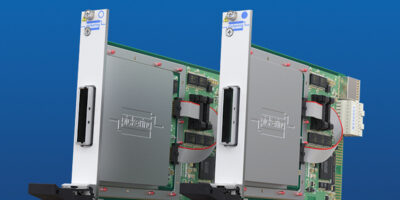New PXI FIUs from Pickering ramp up test system bandwidth
Pickering Interfaces has announced a new addition to its range of PXI FIU (fault insertion unit) switch modules. Available in a compact single-slot form factor, models
40-205 (PXI) and 42-205 (PXIe) are part of the company’s two-wire serial interface fault insertion switching family. Based on MEMS (micro-electro-mechanical systems) switches, the modules are designed to simulate common faults in high-speed communication protocols, supporting the latest evolution of MultiGBASE-T1 testing requirements.
The modules are designed primarily for automotive HIL (hardware-in-the-loop) simulation applications, specifically for design verification of the latest high-bandwidth MultiGBASE-T1 Ethernet networking components, such as ADAS (advanced driver-assistance systems) controllers, with networking data speeds currently reaching up to 10 Gbps. The FIU is used to validate the safe and consistent operation of the controller in the presence of various connectivity faults. Single pair Ethernet is also seeing increased usage in aerospace and industrial applications due to its ease of implementation, lower cost, and reduced weight compared to standard Ethernet CAT 5/6 cabling.
With four or eight channels of impedance-matched 2-wire signal paths, communication protocols ranging from legacy 10BASE-T1 to the latest 10GBASE-T1 automotive Ethernet standard are supported in a single product, allowing users to futureproof their systems as testing requirements evolve. In the default position, the 2-wire channels directly pass through the module without significant signal loss. Alternatively, any wire can be set as open-circuit, or shorts can be applied across wire pairs. Fault connections can also be made to one of four external signals via two fault buses, each with EMR changeover connectivity, typically simulating connections to supply voltage/ground, or resistive faults between channels.
Utilising the latest MEMS switching technology from partner Menlo Micro, the signal channels have low insertion loss and VSWR, as well as repeatable RF characteristics beyond 6 GHz, with each path having a nominally equal insertion loss. The modules also minimise the injection of noise and unwanted signals into the signal path by careful attention to mechanical and electrical design. Each channel can support up to 0.5 A and is rated to 100 V between wire pairs. The pairs have controlled transmission line impedance suited to most single twisted pair signalling systems. The fault buses are each capable of carrying 1.6 A of current, allowing multiple channels to be connected to the same fault condition. Additionally, each fault bus has an EMR changeover relay, allowing the user to select alternative external fault conditions.
To accommodate multiple customer/application-specific MultiGBASE-T1 connector families, the module features a single high-speed connector interface that routes to a breakout accessory, which converts to multiple Rosenberger H-MTD series connectors for the channel connections, along with a 9-way D connector for the fault bus connections. Other automotive Ethernet connector interfaces can be supported on request. Breakout modules are available with mounting options either for cabinet shelves or secured to a 1U standard 19” rack mount panel.
To aid with module ‘health monitoring’, all versions include a relay cycle counting feature, allowing users to identify paths with the highest usage. This information could enable system connections to be revised, allowing signals applied to heavily used contacts to be swapped with those applied to lightly used contacts, thereby prolonging the working life of relays. However, the 3 billion operation specification would represent a significant period of usage before any signal path approaches its operational life.




